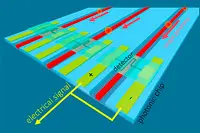 An array of light detectors developed by MIT researchers, in partnership with scientists from IBM and NASA's Jet Propulsion Laboratory, is said to be sensitive enough to register the arrival of individual photons and to have application in quantum computing.
An array of light detectors developed by MIT researchers, in partnership with scientists from IBM and NASA's Jet Propulsion Laboratory, is said to be sensitive enough to register the arrival of individual photons and to have application in quantum computing.
The sensors have been designed to be located on a silicon optical chip, but the team says such single photon detectors are temperamental. However, using standard manufacturing processes, the team has created denser and larger arrays, which are also more sensitive. In experiments, the researchers found their detector was up to 100 times more likely to detect a single photon than earlier arrays.
"Because one will want to make such optical processors with maybe tens or hundreds of photonic qubits, it becomes unwieldy to do this using traditional optical components," says Dirk Englund, an Assistant Professor in Electrical Engineering and Computer Science at MIT. "It's not only unwieldy, but probably impossible, because if you tried to build it on a large optical table, simply the random motion of the table would cause noise on these optical states. So there's been an effort to miniaturise these optical circuits onto photonic integrated circuits."
The process begins with a silicon optical chip made using conventional manufacturing techniques. On a separate silicon chip, they grow a thin, flexible film of silicon nitride, upon which they deposit the superconductor niobium nitride in a pattern useful for photon detection. Gold electrodes were deposited at both ends of the resulting detector.
A droplet of polydimethylsiloxane is attached to the silicon nitride film and a tungsten probe is pressed against it. The probe is used peel the film off its substrate and this is attached to the optical chip.
Whilst previous arrays detected only 0.2% of the single photons, the MIT team's chip reached 20%. However, a practical quantum circuit is likely to require an efficiency of 90% or more, says the team.
Author
Graham Pitcher
Source: www.newelectronics.co.uk

